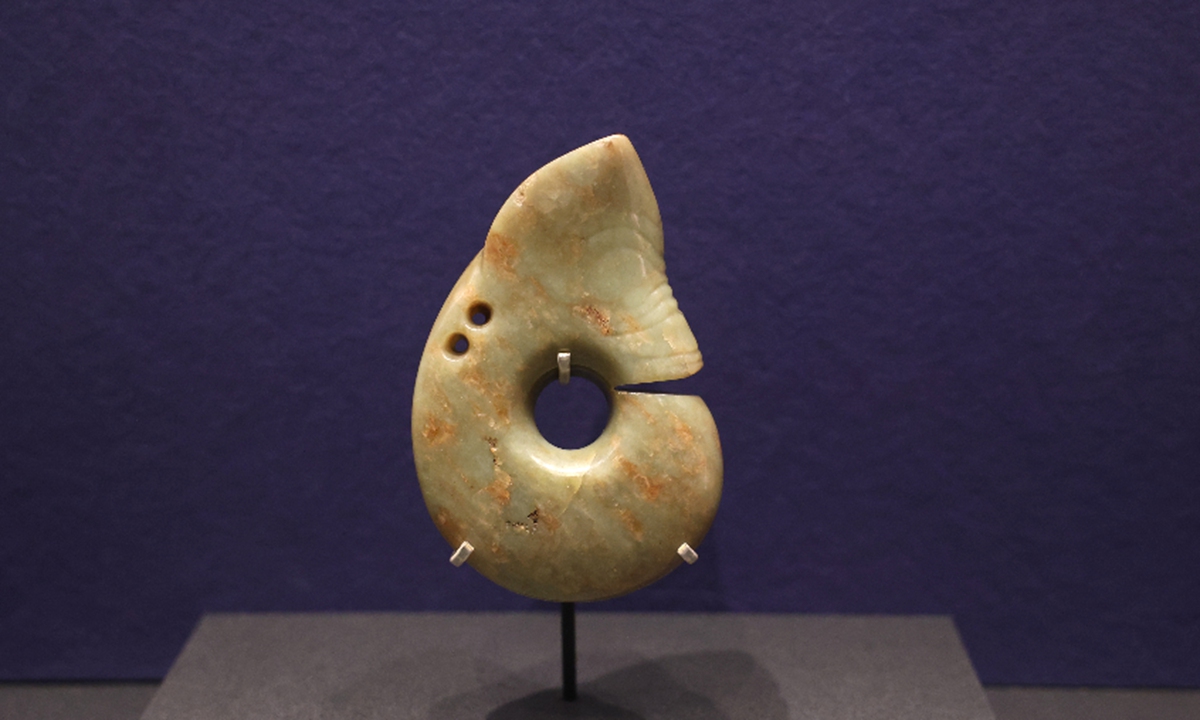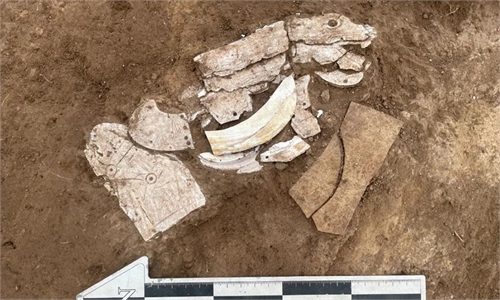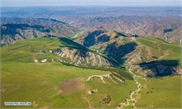ARTS / CULTURE & LEISURE
Hongshan relics provide fresh prehistoric exchange insights
New find bolsters bid for World Heritage status

Hongshan culture, jade Photo: VCG
Numerous discoveries, including three jade dragon artifacts, from the Neolithic Hongshan culture have been discovered in North China's Inner Mongolia Autonomous Region, setting a new annual record for unearthed Hongshan jade dragons in recent years, according to the Xinhua News Agency. Among them, archaeologists uncovered the largest Hongshan jade dragon, which offers fresh insights into the prehistoric culture.Measuring 15.8 centimeters in length, 9.5 centimeters in width, and three centimeters in thickness, the jade pig dragon was discovered in a megalithic tomb in the Yuanbaoshan district of Chifeng, Inner Mongolia. Alongside the dragon, more than 100 other jade artifacts were excavated, including rings, discs, silkworms and owls. According to Xinhua, the jade dragon is a typical representative of the Hongshan culture's jade artifacts. A previously discovered C-shaped jade dragon, now housed in the National Museum of China and renowned for its large size and exquisite craftsmanship, is hailed as the "First Dragon of China."
"This newly unearthed jade dragon is called a 'jade pig dragon,' which is pig-shaped, different from the C-shaped dragon. The C-shaped dragon primarily serves as evidence of the Hongshan people's worship of dragons, marking the emergence of spiritual belief," Sun Jinsong, director of the Inner Mongolia Institute of Cultural Heritage and Archaeology, told the Global Times on Monday.
Hongshan culture is an important prehistoric archaeological culture dating back roughly 5,000 to 6,000 years. Its distribution covers three regions located in the west of Liaoning Province, the north of Hebei Province and the east of Inner Mongolia.
The Hongshan, Lingjiatan (in Anhui Province) and Liangzhu (in Zhejiang Province) cultures are recognized as the three major jade cultures of prehistoric China. Sun noted that despite their geographical distance, these ancient cultures engaged in close interactions.
"The Hongshan culture featured jade owls, while Lingjiatan culture had jade eagles, both reflecting our ancestors' reverence for flight. Meanwhile, the ring-shaped single jade dragons from Liangzhu bear a striking resemblance to Hongshan jade sculptures," Sun noted. "Such exchanges ultimately contributed to the formation of the diverse yet unified Chinese civilization."
This discovery also provides solid empirical evidence for a deeper understanding of the social structure and organizational management of the late Hongshan culture. It contributes to the exploration of the ritual civilization and civilizational process of the ancient Hongshan state. Moreover, it offers strong academic support for the Hongshan culture's bid for World Heritage status, Jin said.
Jin further noted that the Yuanbaoshan megalithic burial mound dates back 5,100 to 5,000 years and is one of the few Hongshan sites in Inner Mongolia that integrates both burial and ritual structures.
The Hongshan culture, an archaeological culture of the Late Neolithic period in northern China, originated around 6,500 years ago and evolved into a proto-state society by approximately 5,800 years ago.
"It is regarded as a crucial component in the study of Chinese civilization's origins, bridging earlier cultures, and helps us delve into the lifestyle, social structure, and cultural development of prehistoric humans," Zhang Yin, a member of the East Asian Archaeological Association, told the Global Times on Monday.
The Yuanbaoshan megalithic tomb was the place where the Hongshan culture originated and is the source of the culture's modern name. To the northeast of Chifeng, where the tomb was found, lies a crimson peak called Wulanhada, which means "Red Mountain" in Mongolian. It is from this peak that the city of Chifeng (Lit: Red Peak) derives its name, and likewise, the Hongshan, or "Red Mountain," culture gets its name.
The year 2024 marked the 70th anniversary of Hongshan culture's formal identification. Among the four Hongshan jade dragons that had been excavated, three are from Inner Mongolia, while the fourth one is from the Zhengjiagou site in North China's Hebei Province. The latter marks the first discovery of Hongshan cultural relics outside the culture's core region.
At the Zhengjiagou site, archaeologists also uncovered a "painted bear head" relief sculpture, measuring 20 centimeters wide and 25 centimeters long. Found in the topsoil layer of a megalithic burial mound, the relief features a construction technique involving sculpting, inlaying colored stones, and applying painted plaster, resembling later mural paintings.
The Zhengjiagou site, dating between 5,100 and 4,800 years ago, exhibits typical Hongshan cultural traits while incorporating local elements, possibly representing a regional variant formed as Hongshan culture spread southwestward and merged with indigenous traditions.
Zhang Wenrui, director of the Hebei Institute of Cultural Relics and Archaeology, noted that current findings suggest that late Hongshan communities may have migrated from Inner Mongolia and Liaoning westward.
"The recent discoveries in Zhangjiakou reinforce the idea that northern Hebei played a crucial role in this migration, providing key evidence of Hongshan culture's expansion. This pattern of movement further supports the broader framework of China's multi-ethnic civilization forming through interactions across regions," Zhang said.



